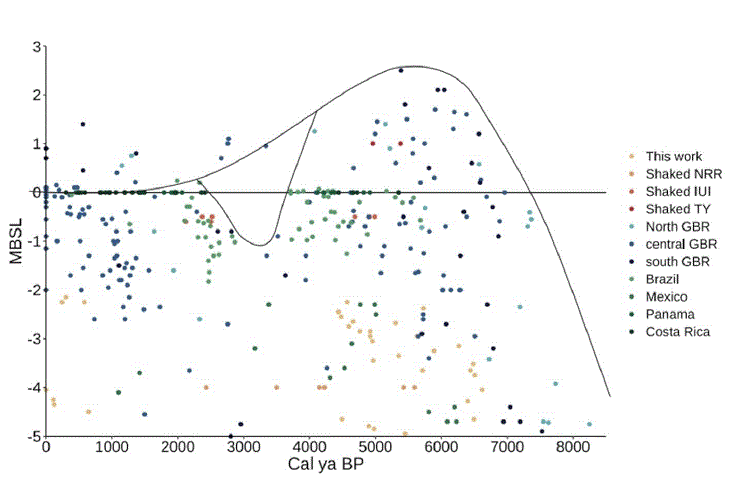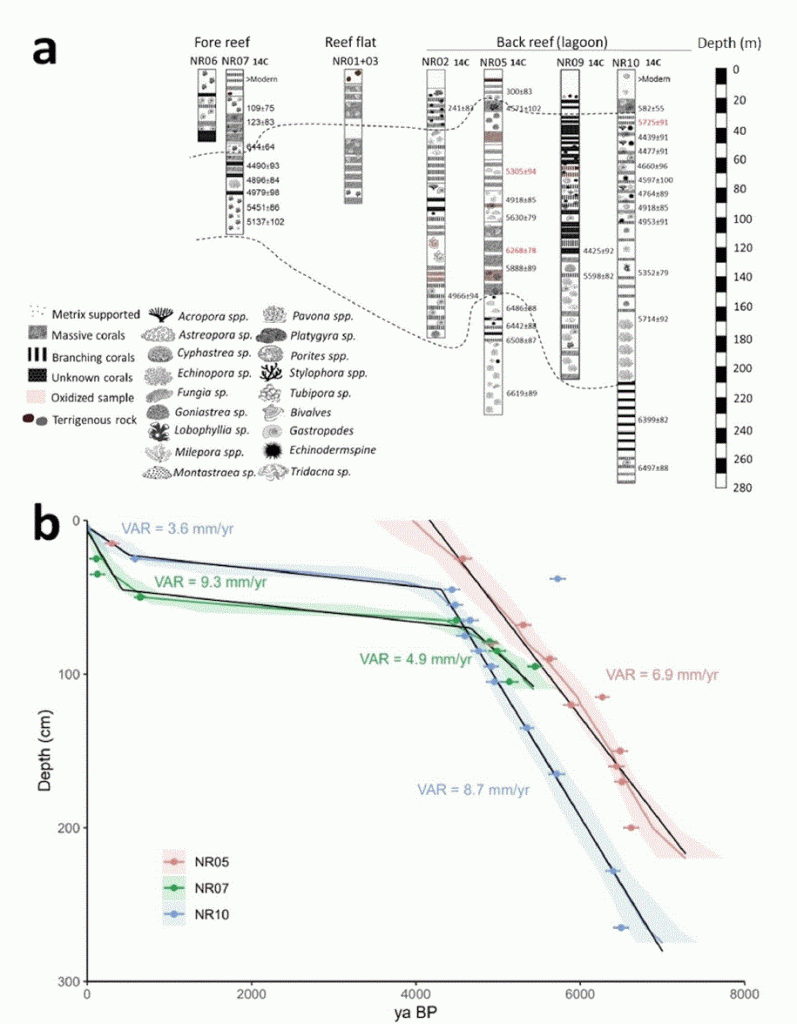Corals around the world stopped growing in 2000BC and the pause lasted two thousand years before they returned like the Phoenix.
Each polyp might be fragile, but coral ecosystems are the couch-grass of the oceans.
A new paper rather puts the man-made panic about corals into perspective.
The most terrible events that could happen to corals have already happened, and the corals appear able to bide their time for two thousand years and return in all their glory.
The worst thing for the worlds corals is not rising seas but falling ones.
We panic over the odd bit of bleaching here and there, but it’s nothing compared to mother nature. The shallow edges of the oceans of the world are savage places. And the best place to study this mayhem is the Red Sea. Not only is it hot, but long, thin, deep, and it’s tectonically active too. In the depths of the last ice age, it was cut off from the Indian Ocean and the salinity rose to a death defying 47% at the Southern end, and 57% in the north. For thousands of years, the Red Sea was pickled.
When the world finally warmed and waters came back 18,000 years ago, baby corals had to travel 2,400 kilometers from the Gulf of Aden to get to Eilat, at the far northern end of the Red Sea, yet they easily did. And the seas kept on rising for thousand of years, and that was all fine and dandy, until disaster struck 4,000 years ago when the seas started to fall, and presumably those delicate polyps were left to bake in the sun.
Feldman et al, studied this phenomenon in the Red Sea and noticed that other scientists have already reported coral growth stagnated in all the major oceans at roughly the same time. For two thousand years there are almost no new fossil corals in any of the cores they drilled. Then somehow, the distinct coral communities that had thrived long before, all reappeared.
Imagine if seas were falling by a few millimeters a year today? The government funded scientists would be raging against the falling of the tide. Whole institutes would be established to move corals to baby nurseries, or special zoos, or to set up seed banks, or to wall off whole reefs. People would be dreaming up schemes to heat the oceans…
But like couch-grass, we couldn’t kill the corals off in the oceans if we wanted to.
Thanks to Kenneth Richard at NoTricksZone for finding this paper:
In this study, we propose not just a local sea level condition causing specific reef turn-offs or hiatuses, but rather a global phenomenon of sea level fall. In light of our findings from Eilat and examining the reports from different locations around the globe (discussed above), we identify a global hiatus in reef growth between approximately 4000 and 2300 years BP (Figure 5). The available studies found almost no fossil corals dated to this time interval at sites across the Atlantic, Indian, and Pacific Oceans (Cortes et al. 1994; Dechnik et al. 2019; Gischler et al. 2008; Perry and Smithers 2011; Shaked et al. 2004, 2005, 2011; Toth et al. 2012),

FIGURE 5 | Reconstruction of global sea level—Compilation of radiocarbon dates from seven sites vs. mean below sea level (MBSL). Possible global sea level curve is presented with demonstrated fall between ~4000–2300 years BP.
Reading the paper is like trawling through an epic biblical drama. Corals want to grow near the surface to harvest the sunlight, so as the seas rise, they just grow upward. When seas stabilize they spread outwards. But the Red Sea has steep sides and the corals can’t expand far. The reef they studied at Eilat at the far northern end, was 1 kilometer long, but only 20m wide. Then just when those delicate corals get settled, a tectonic upheaval blows it away.

(d) Pictures of all seven cores extracted from the lagoon, reef flat and fore reef of the Nature Reserve in Eilat, and some of the coral species that have been found (e) A sketch of Eilat’s Nature Reserve coral reef with all seven extracted cores and their locations. Black arrows on core’s sides represent if were taken from the north (up) or south (down) jetty.
So Feldman et al drill all these cores, and find all the remnants of different species, but when they date the samples they discover there is a kind of Bermuda triangle there in the history of corals. All corals below a certain depth are 4400 years or older, and just above that they are 700 years old. For thousands of years on this reef, the corals were effectively dead.
At some point the corals must have been baked in the sun, and a millennia or two later, they have been reseeded. Perhaps a few remnants struggled on somewhere nearby, or maybe they come from a thousand miles away. But somehow they still came back. The whole ecosystem just resumes where it left off.

FIGURE 2 | (a) Core lithology and coarse coral community structure of all seven cores from the Nature Reserve Eilat. 14C dates (calibrates year BP) as well as U-Th dates are presented at the right side of each core. Dates in red represent age reversals. The upper dashed line separate between recent samples and 4000 yr. dated samples. The middle part separates the 4000 yr. dates and the 5000 yr. samples. Everything beneath the lower line is 6000 yr. and older. (b) Age depth model for cores NR05, NR07 and NR10. Measured ages are marked by colored symbols and error bars (dR = −8 and uncertainty = 33). The model is the black line with error in matching color. Accordingly, the hiatus spans between ~4400 y cal BP and ~ 700 y cal BP.
Spare a thought for all those poor little polyps when the next real crisis comes and we get another Ice Age. Spare a thought for us, too…
REFERENCE
